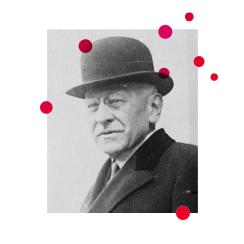
Illustrations by Emmanuel Polanco
John D. Hunting had one thing in mind when, in the mid-1990s, he wrote to the board of Steelcase, the furniture company co-founded by his father, to request an initial public offering. Unusually, it wasn’t that the listing would bring him a fortune worth $150 million.
Instead, he wanted to give it all away.
Hunting had spent a lifetime giving away money. He had tried anonymous donations, then in 1961 set up the Dyer-Ives Foundation, named after his two grandmothers, which would go on to support wayward students at two Michigan academies. In 1982 a second fund, called Beldon, followed, promoting environmental causes. By 1998, Hunting was 68 and reasoned that to see results in his lifetime, he needed to accelerate his largesse. After the Steelcase IPO he sold his shares, restructured the Beldon Fund, and staffed an office in New York with one mission: to spend $100 million in ten years.
Most wealthy individuals set up foundations to exist in perpetuity. But a growing number are adopting Hunting’s approach and flooding a cause with funding within a relatively short space of time. In 2013, Bill Gates announced that the Bill & Melinda Gates Foundation, the largest fund of its kind in the world, would spend out 50 years after the founders die. Warren Buffett has said that he and Gates were inspired by Chuck Feeney, the billionaire founder of Duty Free Shoppers who set up Atlantic Philanthropies in 1982. (It will close in 2020.)
Exact figures are hard to come by, but a study by the Bridgespan Group found that 50 years ago, spend-down strategies accounted for 5 percent of the total assets of America’s 50 largest foundations, compared with 24 percent in 2010. As the number of ultrawealthy people in the world grows, the number of spend-down foundations is expected to rise.
Proponents say that “giving while living” eliminates the high cost of the bureaucracy that comes with running a foundation in perpetuity and the mission drift that can occur after a founder dies. But the evidence is patchy. By spending out, philanthropists leave future generations to grapple with enduring problems on their own — and, quite often, see their own names disappear into oblivion.

Julius Rosenwald. (Wikimedia Commons)
But in their day, another philanthropist was just as well known: Julius Rosenwald, the president and chairman of Sears, Roebuck and Co. He established the Julius Rosenwald Fund in 1917.
Unlike Rockefeller and Carnegie, Rosenwald decided that the fund should be dissolved and all its endowments given to charitable projects within one generation, by 1948. According to its final reports, the Julius Rosenwald Fund gave $22 million to educational and charitable programs in that time period. Among its finest achievements was the establishment of 5,300 schools around the South, serving hundreds of thousands of African-American children — including a school in Alabama where one John Lewis learned to read and write. By funding the education of minorities, Rosenwald helped move America from the Jim Crow era into one of greater civil liberties. But his name has been consigned to history.
Meanwhile, the Rockefeller Foundation, established in 1913, lives on with an endowment of $4.1 billion, and the Carnegie Corporation, established in 1911, has an endowment of $3.3 billion. Although Benjamin Franklin is credited with introducing the concept of philanthropy in the U.S., Rockefeller and Carnegie are the grandfathers of the field. They have been joined by an increasing number of rich men who live on past their time through their great wealth. The word philanthropy comes from the Greek phillein, “to love,” and anthropos, “mankind” — but its biggest practitioners are already dead.
“It’s like a zombie apocalypse,” says Caroline Fiennes, the founder of Giving Evidence, which advises donors, based on hard evidence, on how to give charitably. “Rockefeller, Carnegie — some of the biggest players are not alive.”
Rosenwald was in John Hunting’s mind when he sold $150 million worth of stock and put two thirds of it into the Beldon Fund. “Other than that, I really didn’t give it a lot of thought,” Hunting says by phone from his house in Grand Rapids, Michigan, where he was born and raised. After two years in the army, he studied for a master’s degree in education at the University of Michigan and developed an interest in psychodrama, a psychotherapeutic technique that uses theater to explore psychological well-being, which took him to New York.
As his philanthropy became more ambitious, so did his personal commitment to the environment. Hunting bought a house on Capitol Hill in Washington and retrofitted it with the latest energy-saving technologies. The house became a showroom at fundraisers for pro-environment political candidates; guests would get a speech about the kitchen cabinets, made of toxin-free laminate, and the heating coils embedded under the slate floor. A favorite Hunting party trick was to plunge his hands into a kitchen drawer filled with worms: his very own home-composting system. But he ate out so frequently that there weren’t enough leftovers for the worms, and sometimes he would have to dump in a can of peas.
Hunting must have felt pretty strongly about the environment to embrace a drawer filled with worms and peas. But not all would-be philanthropists are so sure of their causes. That can spell trouble — especially when they have limited time.
Some of the greatest lessons on spending down are emerging from Atlantic Philanthropies. Over 35 years it has given away a total of $8 billion, including the single largest advocacy grant, $27 million, to win passage of the Affordable Care Act in the U.S. More important for other foundations, Atlantic has documented the experiment meticulously and posted its findings online.
The Atlantic project started in earnest when Feeney transferred all of his assets and his entire 38.75 ownership stake in Duty Free Shoppers to the fund in 1984. When the stocks were liquidated a dozen years later, the size of Atlantic’s endowment grew to $3.5 billion.
Feeney did not establish a spend-down strategy from the outset, but it became increasingly clear to staff that this was what he had in mind. He circulated among the staff an essay by Andrew Carnegie about rich people who pledge to donate their money only after death. “Men who leave vast sums in this way,” Carnegie wrote, “may fairly be thought men who would not have left it at all, had they been able to take it with them.”
By the end of the 1990s, Atlantic Philanthropies was spending 10 percent of its endowment annually. But the formal decision to run down the fund did not occur until John Healy became chief executive in 2001. He looked at the books and asked the board to reckon with what was, from the numbers, obvious: Atlantic was spending down.
“If you are pursuing a policy of committing your resources which will have the inevitable end effect of running down the foundation, but you don’t make an explicit decision to run down the foundation, you are storing up a whole heap of trouble for yourself,” Healy said. “Trouble in terms of the staff, who are not stupid and can do the math and will be able to see they won’t have jobs — and trouble in terms of your grantees, to whom you always owe honesty and clarity. I just felt that this was a big gray area.”
In 2002 the trustees decided to formally limit Atlantic’s life to a fixed term, making the fund the biggest experiment yet in spending down. For Healy the major impact this had on strategy was to concentrate the program in a few areas and plan for significant achievements within a set number of years. This became one of the most important lessons from Atlantic: Determine the goals you want to achieve first, then work backward to make a plan for realizing them.
Hunting had established the Beldon Fund with a gift of $100 million. The Atlantic blueprint was still some way off, and Beldon managers initially grappled with defining the scope of the fund’s mission. But they did not take long to narrow the focus, picking two main causes: human health and the environment. Under the guidance of William Roberts, an attorney and economist who had worked for the Environmental Defense Fund, these two areas were complemented by a third, more flexible discretionary fund for opportunistic grants.
“When you’re under a time gun, you have to make tough calls really early,” Roberts says. This was not always easy. One of the strategies Beldon pursued was to build up the strength of environmental advocates in five states: Florida, Michigan, Minnesota, North Carolina, and Wisconsin. When the funding failed to have an impact in Florida, the pressure of the limited time frame forced managers to pull the plug. “It was a hard thing to do — some groups depended on it,” Roberts says. A fund existing in perpetuity, he reasons, might have continued to fund the Florida program even when it was starting to fail.
Tough calls like that helped to strengthen the Beldon Fund’s input in other areas. The environmental groups the fund supported got eight states, including Michigan, Minnesota, and Wisconsin, to ratify the Great Lakes Compact, an agreement sought by environmentalists to prevent the diversion of water from the Great Lakes. In North Carolina, coalitions of advocates were behind clean-water and landfill legislation, power plant regulations, and the creation of a global warming commission.
Regulations, treaties, and commissions are as good a way as any of measuring the success of a fund. Unlike pension funds, foundations have no standardized annual reporting process, or any natural indicator of how things are progressing. “It’s pretty obvious how your pension is going,” says Caroline Fiennes. “But in the philanthropy world, we do not have a single measure of success. You might be funding the elimination of tuberculosis or the campaign to save libraries — there is no unit or metric that spans them all. Furthermore, in many areas of activity, the organizations gather no reliable data on how effective they are.”
Without standardized milestones to aim for, a fund that imposes a fixed term can spend the majority of its time figuring out its focus or working out how to wind down the organization. “You have to get your financial planners to build that mountain,” Bill Roberts says.
That can be tricky; the financial structures of foundations are not set up for flexibility. U.S. law requires foundations to pay out in grants and administrative costs a minimum of 5 percent of their assets each year. In a 2001 study researchers Askash Deep and Peter Frumkin found that foundations stick to this rate largely because everyone else does. They cited “the weight of professional experience and tradition” as one reason to keep the payout rate low.
Even at Beldon, where he was not tied to a 5 percent payout, Roberts found there were few useful planning tools that allowed him to tailor spending to meet program goals. Several times the fund paid out more when a campaign was gathering speed, including large donations to create a collaborative environmental campaign that lobbied against the 2000 decision by the House of Representatives to allow oil drilling in the Arctic National Wildlife Refuge. (The Senate later rejected plans to drill. Subsequent bills have also failed.) Roberts said: “As a perpetual foundation, given our assets, I’m not sure we could have provided that kind of help.”
Atlantic went a step further, reorganizing its investments so that it would have greater flexibility with spending. Rather than being heavily invested in equity, like most foundations, Atlantic sought stability in other assets so it would not have to weather the consequences of dramatic stock market volatility. Illiquid assets like businesses and real estate also had to be unwound in time to feed into grant commitments.
Investment managers faced two related demands from a shrinking portfolio: the need to limit volatility, or avoid the risk of a sudden drop in asset values, and the need to ensure liquidity, or being able to convert assets to cash when needed. Investing like a pension fund in index-linked bonds might have achieved this, but doing so would also have impacted the expected real return on the portfolio of 6 percent (index-linked bonds earn more like 2 percent). The board instead approved heavy investment in absolute-return managers, both in hedge funds and private equity, allowing time for funding to be fully invested and liquidated.
Atlantic began liquidating all of its market-related assets, including equities, bonds, and commodities, which amounted to close to three quarters of a billion dollars, in 2007. Though the timing seemed conservative at the outset, divesting in this way limited the downside during the financial crisis that followed. The value of the Bill & Melinda Gates Foundation fell by a fifth during the 2008 financial crisis, though it did not cut its grant making and its finances have since recovered. Atlantic, in comparison, limited its losses between 2007 and 2009 to 16 percent.
Not long after Gara LaMarche succeeded Healy to become Atlantic’s third chief executive, he wrote to the board and told them it was time to start planning for the end.
“We won’t have a meaningful legacy,” he wrote, “much less the kind we might wish for ourselves, if we don’t think about this now — if we don’t imagine the end of Atlantic and work back from there.”
After ten years at Beldon, Bill Roberts joined Atlantic as director of U.S. advocacy just as it was beginning to think about its end goals. At Beldon, Roberts had learned that you cannot tell a grantee enough times that you’re going to stop funding. “The power of denial is a strong force,” he says. “Here’s an example where we made a mistake. We knew who we were going to be funding to the end, and yet we still had an open-door policy for funding proposals. Some people viewed it as disingenuous.”
At Atlantic and later at the John Merck Fund, Roberts promoted the idea of transparency so that grantees could be prepared. For Roberts, “the most specific metrics were making sure we entered the field responsibly and left responsibly.”

“A lot is expected from us in philanthropic endeavors,” Chuck Feeney wrote in a letter to Bill Gates in 2011, “and not all good initiatives will be met with universal positive acclaim — but this challenge should not divert each of us from making philanthropic investments in what we thoughtfully believe to be the highest and best use of our resources.”
Larry Brilliant, the chief executive of Google’s charitable arm, Google.org, believes funders need to keep making mistakes. “We need more experiments,” he says, noting that “$100 million may seem like a lot of money, but it’s trivial compared to government budgets that run into the trillions. Foundations must be experimental and catalytic, and fund the things that governments won’t.”
When foundations are transparent about what works and what doesn’t, the next generation of philanthropists can build on the best traditions. Having an impact — and being around to witness it — remains the greatest motivator for philanthropists who choose to donate their wealth while they are alive. “The challenges, even setbacks, I have experienced in my decades of personal engagement in philanthropy pale in comparison to the impact and deep personal satisfaction we have realized,” Feeney says.
Hunting agrees: “There’s no sense in saving our money while the planet is burning up.”
What happens to a funder when a foundation ends? On the phone from his home in Grand Rapids, Hunting says: “I thought I’d give it my good ten years, and at 78 I’d be through.”
Beldon closed in 2008. In 2016, Hunting made the decision to shut down the Dyer-Ives Foundation. The portraits of his grandmothers still watch over the conference table in his office downtown — and the Dyers-Ives Poetry Contest turns 50 this year, making it perhaps the oldest such competition in the U.S. But after a lifetime in philanthropy, 87-year-old Hunting misses the people and participating in civic life through philanthropy.
“I wish I had kept it running and had it closed down when I died,” he says. “I figured that out a couple of months after it closed.”





